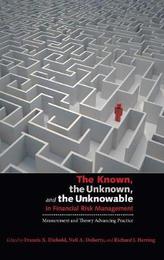
|
The Known, the Unknown, and the Unknowable in Financial Risk Management: Measurement and Theory Advancing Practice
Hardback
Main Details
| Title |
The Known, the Unknown, and the Unknowable in Financial Risk Management: Measurement and Theory Advancing Practice
|
| Authors and Contributors |
Edited by Francis X. Diebold
|
|
Edited by Neil A. Doherty
|
|
Edited by Richard J. Herring
|
| Physical Properties |
| Format:Hardback | | Pages:392 | | Dimensions(mm): Height 235,Width 152 |
|
| Category/Genre | Finance |
|---|
| ISBN/Barcode |
9780691128832
|
| Classifications | Dewey:658.155 |
|---|
| Audience | | Tertiary Education (US: College) | | Professional & Vocational | |
|---|
| Illustrations |
4 halftones. 31 line illus. 23 tables.
|
|
Publishing Details |
| Publisher |
Princeton University Press
|
| Imprint |
Princeton University Press
|
| Publication Date |
9 May 2010 |
| Publication Country |
United States
|
Description
A clear understanding of what we know, don't know, and can't know should guide any reasonable approach to managing financial risk, yet the most widely used measure in finance today--Value at Risk, or VaR--reduces these risks to a single number, creating a false sense of security among risk managers, executives, and regulators. This book introduces a more realistic and holistic framework called KuU --the K nown, the u nknown, and the U nknowable--that enables one to conceptualize the different kinds of financial risks and design effective strategies for managing them. Bringing together contributions by leaders in finance and economics, this book pushes toward robustifying policies, portfolios, contracts, and organizations to a wide variety of KuU risks. Along the way, the strengths and limitations of "quantitative" risk management are revealed. In addition to the editors, the contributors are Ashok Bardhan, Dan Borge, Charles N. Bralver, Riccardo Colacito, Robert H. Edelstein, Robert F. Engle, Charles A. E. Goodhart, Clive W. J. Granger, Paul R. Kleindorfer, Donald L. Kohn, Howard Kunreuther, Andrew Kuritzkes, Robert H. Litzenberger, Benoit B. Mandelbrot, David M. Modest, Alex Muermann, Mark V. Pauly, Til Schuermann, Kenneth E. Scott, Nassim Nicholas Taleb, and Richard J. Zeckhauser. * Introduces a new risk-management paradigm * Features contributions by leaders in finance and economics * Demonstrates how "killer risks" are often more economic than statistical, and crucially linked to incentives * Shows how to invest and design policies amid financial uncertainty
Author Biography
Francis X. Diebold is the Paul F. and E. Warren Shafer Miller Professor of Economics at the University of Pennsylvania and professor of finance and statistics at the university's Wharton School. Neil A. Doherty is the Frederick H. Ecker Professor of Insurance and Risk Management at the Wharton School. Richard J. Herring is the Jacob Safra Professor of International Banking and professor of finance at the Wharton School.
ReviewsWinner of the 2012 Kulp-Wright Book Award, American Risk and Insurance Association Finalist for the 2010 Paul A. Samuelson Award, TIAA-CREF "It is a bold book, tackling both theory and practice and spanning the worlds of (among others) banking, insurance, real estate, and investment. It is also utterly engrossing... Although this book is most obviously addressed to risk managers and regulators, I think it should be read by every intellectually curious person with skin in the financial game. If the investor or trader doesn't come away with at least one or two ideas of practical importance to his financial life, he is a 'sleepreader.'"--Brenda Jubin, Reading the Markets blog "Peppered with anecdotes and prominent examples, the book never abandons the practical side of its topic. It will be helpful for readers interested in only specific subtopics that each article is a stand-alone piece. I recommend this book to a wide audience: academics and practitioners, of course, but even people who are not directly involved in the financial sector, but are interested in it, will find it definitely worth their time."--Tobias Nigbur, Financial Markets and Portfolio Management
|